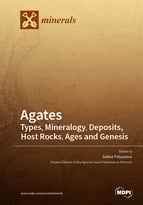Agates: Types, Mineralogy, Deposits, Host Rocks, Ages and Genesis
A special issue of Minerals (ISSN 2075-163X). This special issue belongs to the section "Mineral Deposits".
Deadline for manuscript submissions: closed (15 July 2021) | Viewed by 47844
Special Issue Editor
2. Department of Geology and Geophysics, Novosibirsk State University, 630090 Novosibirsk, Russia
Interests: ore-forming processes; experiment; thermodynamic modeling; minerals-indicators; fluid−mineral−rock interactions; gold mineralization; gold deposits; mechanisms of ore formation; reconstruction of T,P,X-conditions
Special Issues, Collections and Topics in MDPI journals
Special Issue Information
Dear Colleagues,
You are welcome to contribute papers to the Special Issue "Agates: Types, Mineralogy, Deposits, Host Rocks, Ages, and Genesis".
Agates are beautiful and fascinating stones found all around the world. They are microcrystalline quartz nodules found in veins and cavities in host rocks. Agates have been observed in various kinds of host rocks. They are classically associated with volcanic rocks and can be found in sedimentary, metamorphic, and igneous environments. Agates are characterized by a wide variety of colors, shades, and patterns. There are more than 100 varieties of this stone. Agates are unique in their original patterns, but a layered texture is considered to be more common. Although agates are composed almost entirely of SiO2, it is the trace quantities of various other elements that give agates their color and lead to their characteristic banding. Carbonates, zeolites, and iron and manganese oxides are often found in agates. Ore-forming minerals, such as sulfides of iron, zinc, lead, and copper, and native metals are rarely found in them.
Despite many in-depth studies and improving technologies and investigative methods, the source of the silica required for the growth of agate remains largely unknown. The complex, multi-step process of agate formation is not yet completely understood. In these small eternal pebbles, as in the microworld, powerful natural processes that occurred hundreds of millions of years ago are also reflected.
The aim of this Special Issue is to bring together researchers from different disciplines to further our understanding of the genesis of agates.
Dr. Galina Palyanova
Guest Editor
Manuscript Submission Information
Manuscripts should be submitted online at www.mdpi.com by registering and logging in to this website. Once you are registered, click here to go to the submission form. Manuscripts can be submitted until the deadline. All submissions that pass pre-check are peer-reviewed. Accepted papers will be published continuously in the journal (as soon as accepted) and will be listed together on the special issue website. Research articles, review articles as well as short communications are invited. For planned papers, a title and short abstract (about 100 words) can be sent to the Editorial Office for announcement on this website.
Submitted manuscripts should not have been published previously, nor be under consideration for publication elsewhere (except conference proceedings papers). All manuscripts are thoroughly refereed through a single-blind peer-review process. A guide for authors and other relevant information for submission of manuscripts is available on the Instructions for Authors page. Minerals is an international peer-reviewed open access monthly journal published by MDPI.
Please visit the Instructions for Authors page before submitting a manuscript. The Article Processing Charge (APC) for publication in this open access journal is 2400 CHF (Swiss Francs). Submitted papers should be well formatted and use good English. Authors may use MDPI's English editing service prior to publication or during author revisions.
Keywords
- varieties of agates
- textures in agates
- the growth of agates
- mineralogy of agates
- sulfides, oxides, native metals, and other associated minerals in agates
- xenoliths in agates
- deposits of agates
- T,P,X-conditions of formation
- age of agates
- trace element abundance in agates
- occurrence and formation of agates






